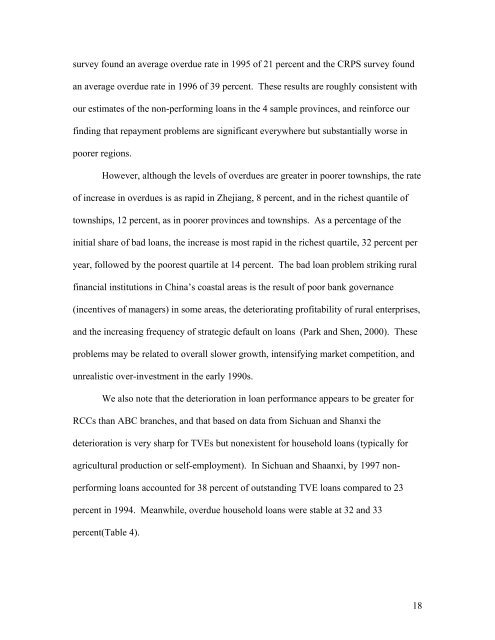Are China's Financial Reforms Leaving the Poor Behind - Harvard ...
Are China's Financial Reforms Leaving the Poor Behind - Harvard ...
Are China's Financial Reforms Leaving the Poor Behind - Harvard ...
Create successful ePaper yourself
Turn your PDF publications into a flip-book with our unique Google optimized e-Paper software.
survey found an average overdue rate in 1995 of 21 percent and <strong>the</strong> CRPS survey foundan average overdue rate in 1996 of 39 percent. These results are roughly consistent withour estimates of <strong>the</strong> non-performing loans in <strong>the</strong> 4 sample provinces, and reinforce ourfinding that repayment problems are significant everywhere but substantially worse inpoorer regions.However, although <strong>the</strong> levels of overdues are greater in poorer townships, <strong>the</strong> rateof increase in overdues is as rapid in Zhejiang, 8 percent, and in <strong>the</strong> richest quantile oftownships, 12 percent, as in poorer provinces and townships. As a percentage of <strong>the</strong>initial share of bad loans, <strong>the</strong> increase is most rapid in <strong>the</strong> richest quartile, 32 percent peryear, followed by <strong>the</strong> poorest quartile at 14 percent. The bad loan problem striking ruralfinancial institutions in China’s coastal areas is <strong>the</strong> result of poor bank governance(incentives of managers) in some areas, <strong>the</strong> deteriorating profitability of rural enterprises,and <strong>the</strong> increasing frequency of strategic default on loans (Park and Shen, 2000). Theseproblems may be related to overall slower growth, intensifying market competition, andunrealistic over-investment in <strong>the</strong> early 1990s.We also note that <strong>the</strong> deterioration in loan performance appears to be greater forRCCs than ABC branches, and that based on data from Sichuan and Shanxi <strong>the</strong>deterioration is very sharp for TVEs but nonexistent for household loans (typically foragricultural production or self-employment). In Sichuan and Shaanxi, by 1997 nonperformingloans accounted for 38 percent of outstanding TVE loans compared to 23percent in 1994. Meanwhile, overdue household loans were stable at 32 and 33percent(Table 4).18















